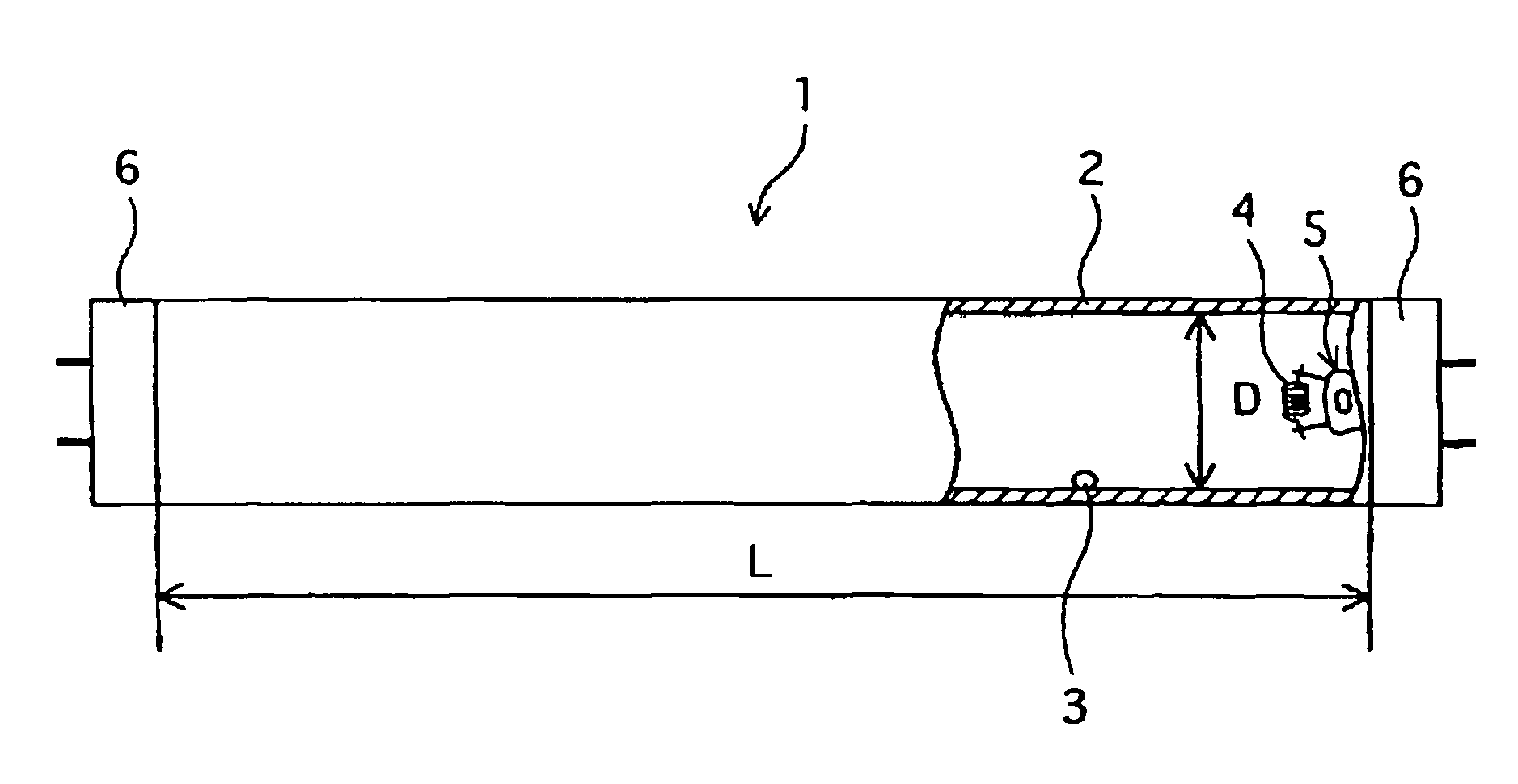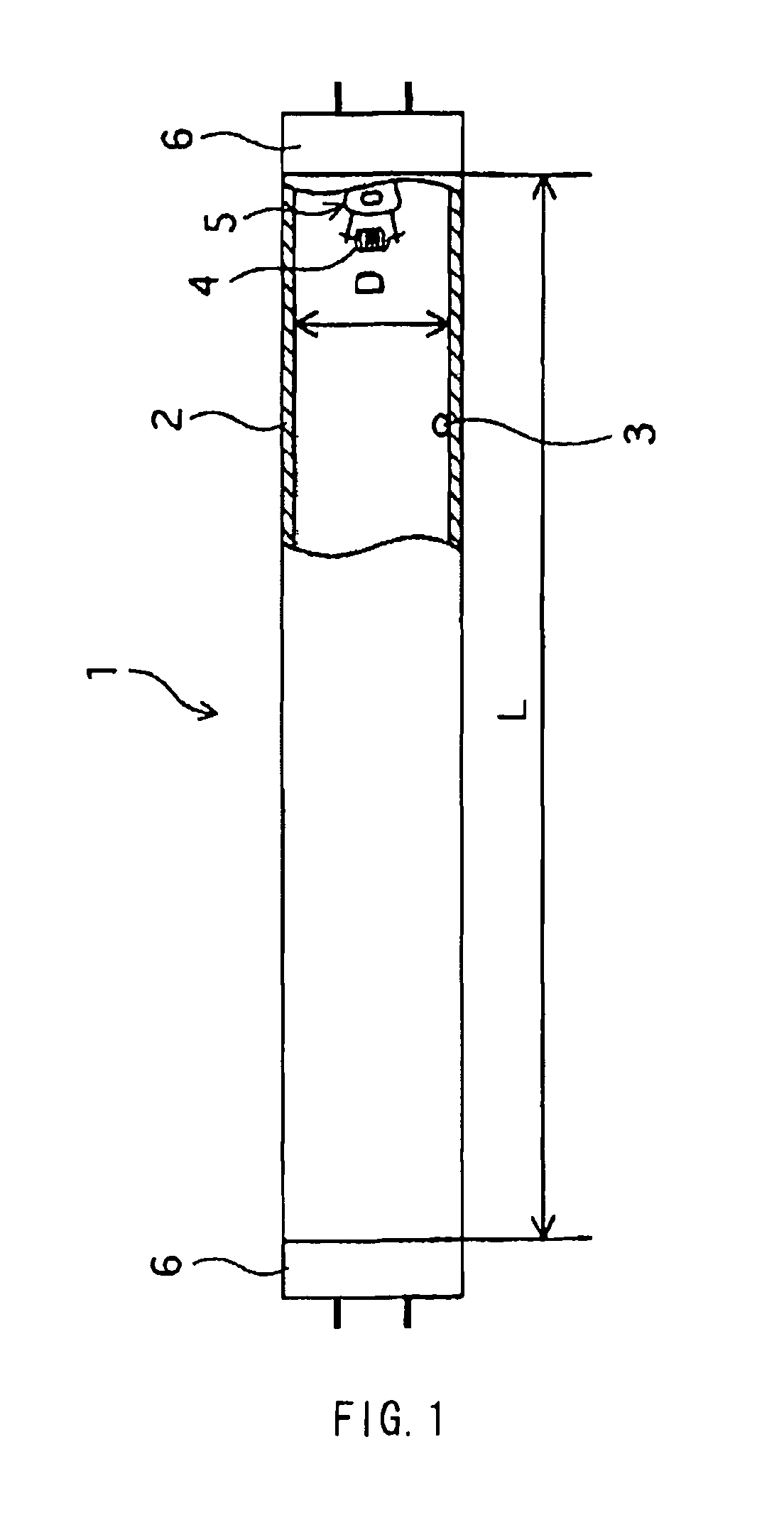Fluorescent lamp, luminaire and method for manufacturing fluorescent lamp
a technology of fluorescent lamps and luminaires, which is applied in the manufacture of electrode systems, electric discharge tubes/lamps, and discharge tubes luminescent screens, etc., can solve the problems of high surface tension of mercury, difficult to accurately measure off a small amount of mercury, and large loss of mercury during enclosure, etc., and achieves less prone to peeling
- Summary
- Abstract
- Description
- Claims
- Application Information
AI Technical Summary
Benefits of technology
Problems solved by technology
Method used
Image
Examples
example 1
(1) Configuration of Fluorescent Lamp
[0046]FIG. 1 is a partially cut-away plan view of a straight-shape fluorescent lamp according to one example. As shown in FIG. 1, a fluorescent lamp 1 is a straight-shape fluorescent lamp exclusively for high frequencies (power consumption: 32 W), and includes a glass bulb 2 made of soda-lime glass.
[0047]The glass bulb 2 has a tube internal diameter D of 23.5 mm and a discharge path length L of 1178 mm, whereby L2 / D is 59050. On an internal face thereof, a protective layer and a phosphor film (not shown) are laminated successively, while an amalgam pellet 3 for supplying mercury vapor and argon gas as rare gas are enclosed therein. Glass mounts 5 having electrodes 4, respectively, are fixed in both ends of the glass bulb 2 so as to be enclosed in the bulb, and the ends of the glass bulb 2 are capped with bases 6, respectively.
[0048]The amalgam pellet 3 is in an approximately spherical shape, having an average spherical diameter of 1.2 mm, a weigh...
example 2
(1) Configuration of Fluorescent Lamp
[0060]FIG. 6 is a partially cut-away plan view illustrating a ring-shape fluorescent lamp of Example 2 of the present invention. As shown in FIG. 6, a fluorescent lamp 21 is a ring-shape fluorescent lamp (power consumption: 40 W) including a glass bulb 22 made of soda-lime glass.
[0061]The glass bulb 22 has a tube internal diameter D of 27 mm and a discharge path length L of 1026 mm, whereby L2 / D is 38988. On an internal face thereof, a protective layer and a phosphor film (not shown) are laminated successively, while an amalgam pellet 23 for supplying mercury vapor and argon gas as rare gas are enclosed therein. Glass mounts 25 having electrodes 24, respectively, are fixed in both ends of the glass bulb 22 so as to be enclosed in the bulb, and a base 26 is attached to the ends of the glass bulb 22 so as to cover the same.
[0062]The amalgam pellet 23 is in an approximately spherical shape, having an average spherical diameter of 1.3 mm, a weight of...
example 3
[0095]Fluorescent lamps according to Example 1 were prepared, in which amalgam pellets shown in Table 4 were enclosed, respectively, and the number of fluorescent lamps in which mercury adhered to the thin tubes was determined. The result is shown in Table 4 below.
[0096]
TABLE 4Number of lampswith mercuryZnHgadhesion to thinValue AmixtureHg amounttubes(SnHg mixture ratio)ratio(mg)(among 10 lamps)0.50.5500.80.2500.90.1511.0054
[0097]Table 4 shows that regarding the adhesion of mercury to the thin tube, a preferable result was obtained when A<0.9.
PUM
 Login to View More
Login to View More Abstract
Description
Claims
Application Information
 Login to View More
Login to View More - R&D
- Intellectual Property
- Life Sciences
- Materials
- Tech Scout
- Unparalleled Data Quality
- Higher Quality Content
- 60% Fewer Hallucinations
Browse by: Latest US Patents, China's latest patents, Technical Efficacy Thesaurus, Application Domain, Technology Topic, Popular Technical Reports.
© 2025 PatSnap. All rights reserved.Legal|Privacy policy|Modern Slavery Act Transparency Statement|Sitemap|About US| Contact US: help@patsnap.com



